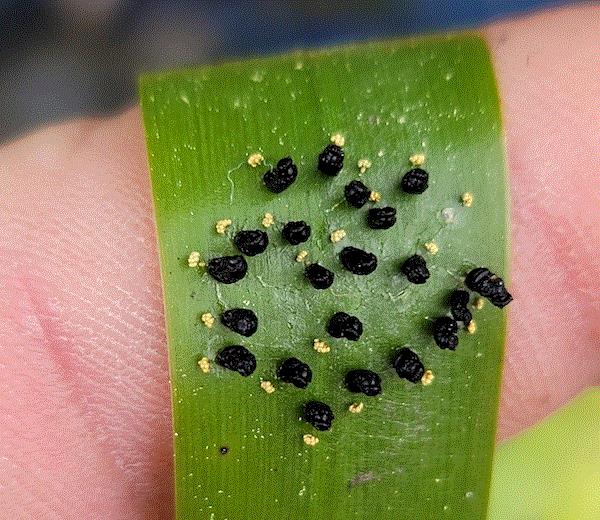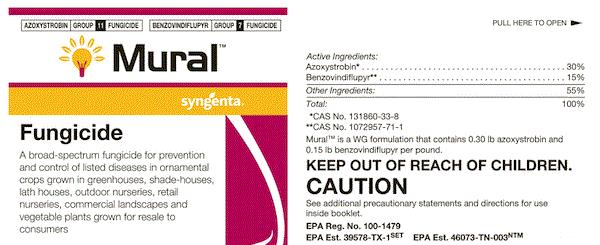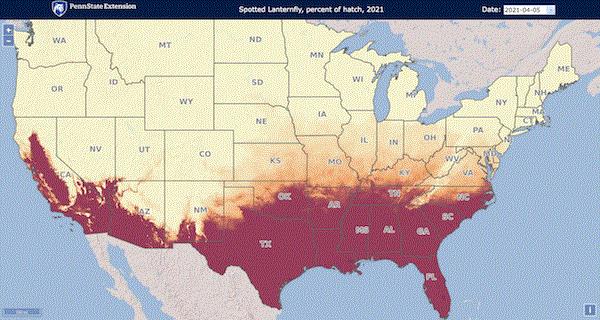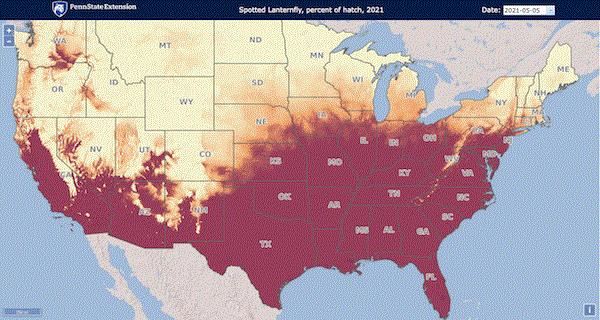What the ... ?
I don't know everything, even things entomological. The picture TJ Savereno of Clemson University Extension sent me this week is a good reminder of that fact.
It looks like some pupae or doo-doo on a walking iris leaf. I have no idea what they are, so I had to call out to my colleagues for help.

What are these? The answer is at the end of today’s newsletter.
IR-4 updated two herbicide crop safety summaries
IR-4 recently updated the crop safety summaries of two herbicides: indaziflam (Marengo; WSSA 29) and isoxaben + dithiopyr (Fortress; WSSA 21 + 3).
Crop safety summary for indaziflam was last published by IR-4 about a year ago. Indaziflam is a pre-emergent herbicide for the management of annual broadleaf and grassy weeds. Two formulations are available for use on ornamentals—granular or Marengo G (0.0224% a.i.), and suspension concentrate or (simply) Marengo (7.4% a.i., but sometimes denoted as 0.622 SC or 74SC).IR-4 conducted 159 crop safety trials on three formulations from 2011 to 2020. The G formulation was tested against 34 plant species, with five species (acuba, barberry, liriope, mondograss and viburnum) exhibiting no injury, eight species exhibiting injury at two or four times the label rate, and six species with significant injury.
The SC formulation was tested against 26 plant genera or species. No phytotoxicity was observed on Norway spruce, but more data are needed for other species. Click HERE for a copy of the indaziflam crop safety summary.
Fortress is a granular pre-emergent herbicide against a wide range of broadleaf and grassy weeds. IR-4 evaluated the crop safety of Fortress on 17 plant genera or species from 2018 to 2020. Fortress was applied over-the-top at 150 (label rate), 300 and 600 lbs. per acre at six-week intervals. Applications didn’t cause damage to bigleaf, oakleaf and paniculate hydrangeas, but label rate caused significant injury to yellow and biennial foxgloves. Crop safety data on other plant species are still needed. Click HERE for a copy of the Fortress crop safety summary.

Mural now in California
Syngenta announced last week that Mural fungicide is now available in California. Mural contains azoxystrobin and benzovindiflupyr (FRAC 11 + 7), and is registered for use on ornamental plants and vegetable transplants in greenhouses, shadehouses, lath houses, nurseries (including retail) and landscapes. This fungicide provides preventive and systemic management of many diseases, including Anthracnose, Botrytis, downy mildew, various leaf spots, various leaf and stem blights, Phomopsis, powdery mildew, Rhizoctonia and rusts. Mural can be applied as a foliar spray or medium drench.

The required personal protective equipment includes long-sleeved shirt, long pants, shoes plus socks, chemical resistant gloves, and protective eyewear. The restricted entry interval is 12 hours.
Click HERE to find more information on Mural, including efficacy trial summaries.
SLF egg hatch predictor
A couple of weeks ago, Brian Walsh, spotted lanternfly (SLF) aficionado at Pennsylvania State University Extension, told me that the SLF emergence predictor is now available. The online tool is developed by Dennis Calvin and Stephen Crawford of Penn State using degree-day models of SLF egg hatch from Pennsylvania and Virginia.
The tool extracts temperature data from weather stations around the country and applies degree-day models to estimate the percentage of eggs that have hatched on any day up to today. The percent of eggs hatched is then presented on a map as a range of colors. The maps below show the prediction for April 5 (top) and May 5 (bottom), 2021.
Click HERE to access the predictive tool.



Here come the disclaimers (not that I don't trust your intelligence and common sense, but I don't want anyone to get in trouble because someone misunderstands the limitations of this tool):
-
The tool shows percent of egg hatch on the entire map of the United States. Does it mean SLF is everywhere? NO! SLF hasn’t been found in the Columbia River wine country even though the region is colored on the map, so please don't panic. You can find out if SLF has been confirmed in your state and county by clicking HERE. You can zoom in on an area and toggle the “county” button at the bottom of the predictive map to display the county line. This predictive tool is meant to help folks in the infested areas start their monitoring and management programs, and for folks adjacent to the infested areas to start monitoring.
-
This online tool is based on real-time temperature data extracted from local weather stations. It can predict the percentage of egg hatch up to the day you use the tool. It cannot predict what will happen two weeks from now because the temperature data in the future aren’t available yet.
-
Is the predicted percent egg hatch 100% accurate? Hell, no! I challenge anyone to give me a prediction that is 100% accurate. Otherwise, shouldn't we call that a destiny? The predictions can get better and better because researchers are able to refine their degree-day models as they gather more data over time.
-
Another reason the prediction cannot be 100% accurate everywhere is the fact that landscape features and microclimate—such as a north-facing slope, heat island and heat shelter—can cause variations in local temperature. Those variations can cause some deviations from the models.
-
Lastly, eggs in the same clutch can hatch over a two-week period. When the tool predicts 100% egg hatch, it doesn't mean all eggs in the areas have hatched. It means there's a likelihood that some eggs in the egg mass have hatched. There’ll be more hatching coming in the weeks to come.
-
The tool is a bit slow to load, especially if you live in the woods and have only a DSL line as your connection to the digital world, so be patient. Just in case the link in this newsletter doesn't bring you directly to the tool, copy and paste this link on your web browser: https://tools.cei.psu.edu/slf. (Ask your elders if you're too young to know or remember what DSL is.)
Play with it and use it to help you plan for SLF management!

Answer to “What the … ?”
The mystery this week finds a group of pupae of the parasitic wasp genus Eulophus. The black things are the pupae and the yellow things are the meconia. (Meconium, singular, is basically the last bit of waste expelled from a wasp larva’s gut before it becomes a pupa.)
Larvae of Eulophus are external parasites that latch on to caterpillars and suck hemolymph (you can think of this as bug blood, however, it's not green like in the movies), and other tissues and nutrients from the caterpillars. There's no way of knowing who the unfortunate victim is since the caterpillar wasn’t found with the murderers.
Shout-out to Jeremy Slone of Bartlett Tree Experts and PJ Liesch of the University of Wisconsin for solving this mystery. Donald Lewis of Iowa State University told me that these wasp pupae are also called “tombstone” pupae. Not sure who started calling them “tombstone” pupae. The earliest reference I can find is in Samuel Hubbard Scudder’s "Butterflies of the Eastern United States and Canada with Special Reference to New England" (1889). It’s pretty easy to tell why Scudder referred to them as the “tombstone” pupae—they sure look like tombstones, don't they?
Scudder puts it best, “And still another parasite [a species of Eulophus], the coal-black chrysalides of which one may sometimes find to the number of twenty or more, standing erect on their hinder ends around the corpse they have destroyed, like tombstones in a cemetery, a most melancholy spectacle on opening a nest to get a young caterpillar.”




See y'all later!

JC Chong
Professor of Entomology at Clemson University
This e-mail received by 23,505 subscribers like you!
If you're interested in advertising on PestTalks contact Kim Brown ASAP!